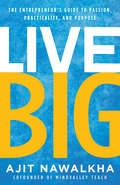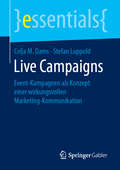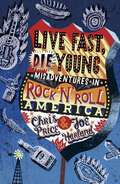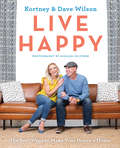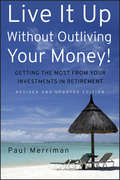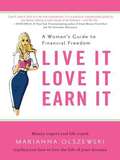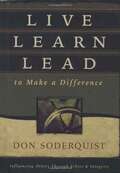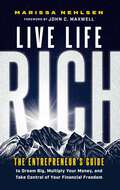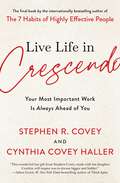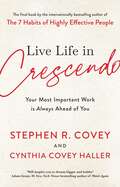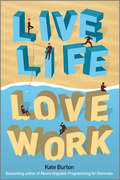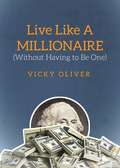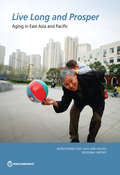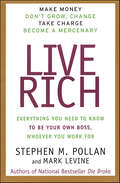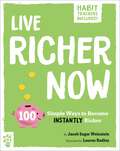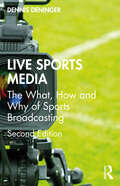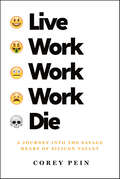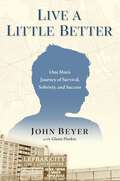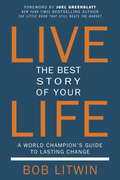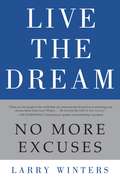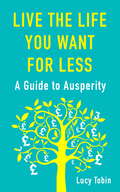- Table View
- List View
Live Big: The Entrepreneur's Guide to Passion, Practicality, and Purpose
by Ajit NawalkhaYou have the power to accomplish goals, create an impact, and live the life you want. The key to achieving what you set out for--in business and in life--doesn't lie in perfectly executed strategy. The greatest tool you have is your own mindset—it determines your ability to adapt and persevere. And, like any other tool, you can employ it to your advantage. While most aspiring entrepreneurs think the next business strategy will manifest the life they desire, successful entrepreneurs know it's the emotional and mental "shifts" that will bring you closer to your goals. No one is better equipped to explore these shifts than Ajit Nawalkha, cofounder of Mindvalley and one of the world's leading entrepreneurs and business coaches. In Live Big: A Guide to Passion, Practicality, and Purpose, Nawalkha shares 25 shifts—changes in your mental, physical, emotional, or even spiritual state—that will propel you on your road to success. Through Nawalkha's expertise, discover how this book will: • Bring you out of any funk or stagnant revenue cycle • Give you the emotional, spiritual, and mental power to fight the ups and downs of business • Show you ways to deal with everyday challenges, find comfort in them, and get past them in 20 minutes or less • Help you cope with &‘entrepreneurial anxiety' and find purpose, passion, and bliss in your business Live Big is the go-to guide for business owners and entrepreneurs who want to be in a state of flow and creativity, to ensure your passion is backed by purpose and practicality. With principles and foundational thinking habits that allow you to move from a place of defeat and anxiety to one of joy and contribution to humanity, this book will serve as a compass that you can pick up and find direction to keep moving forward in today's world of entrepreneurship.
Live Campaigns: Event-kampagnen Als Konzept Einer Wirkungsvollen Marketing-kommunikation (Essentials)
by Colja M. Dams Stefan LuppoldColja M. Dams und Stefan Luppold geben in diesem essential Anstöße, formulieren Antworten, erklären Zusammenhänge und treten den Beweis an für den Erfolg von neuen Marketing-Konzepten in der gelebten Praxis. Mithilfe von Beispielen aus der Praxis für die Praxis zeigen die Autoren: Live Campaigns verändern die Event-Topografie grundlegend und stellen die Face-to-Face-Kommunikation in den Mittelpunkt, weg von einem reinen Kommunikationskanal und hin zu dem zentralen POC (Point of Content). Dabei spielen Interaktion und Zielgruppen ebenso eine wichtige Rolle wie die Möglichkeit, ein solches Konzept ohne zeitliche Begrenzung zu fahren.
Live Fast, Die Young: Misadventures in Rock And Roll America
by Chris Price Joe HarlandDisappointed to learn that Hotel California isn’t actually in the phone book, radio producers Chris and Joe resolve to seek out the true spirit of rock and roll America. Roof down and stereo up, they drive coast to coast on a mission to ‘live the music’. It’s a tale of friendship tested to the limit, great melodies, and noble myths.
Live Fast, Die Young: Misadventures in Rock And Roll America
by Chris Price Joe HarlandDisappointed to learn that Hotel California isn’t actually in the phone book, radio producers Chris and Joe resolve to seek out the true spirit of rock and roll America. Roof down and stereo up, they drive coast to coast on a mission to ‘live the music’. It’s a tale of friendship tested to the limit, great melodies, and noble myths.
Live Happy: The Best Ways to Make Your House a Home
by Dave Wilson Kortney WilsonFrom the beloved couple behind Masters of Flip, a warm and inviting guide to making wherever you are feel like homeHome isn’t just a place to sleep and eat. It’s a haven—a place of refuge from the world, of connection with the people (and pets) you hold most dear, of celebration of life’s biggest moments and of recuperation from the exhaustion of the day. Kortney and Dave Wilson have built their careers and a beloved HGTV show, Masters of Flip, around creating houses that people instantly recognize as home. They build colour, joy and family into the design of every house they flip in Nashville, Tennessee, because those priorities are what shape their lives. Live Happy offers hundreds of fresh, fun ideas for how readers and fans of Masters of Flip can inexpensively and creatively build joy into their lives and their homes. From the reason you should always live close to the ice cream shop to the definitive philosophy for dealing with your junk drawer, it will help you make a new house into a home or inject new life into your forever home. It will go beyond design to personal connections, with stories of how Kortney and Dave found each other, built new dreams together and manage to have a happy marriage (and business!) while raising three amazing children. Full-colour and heavily illustrated, Live Happy will feature over 200 photos drawn from Kortney and Dave’s family and design projects. Think of it as The Wisdom of Sundays meets Domino with a shot of The Magnolia Story. Through it all, Kortney and Dave’s voices will be in hilarious and heartfelt conversation in the way fans have come to know and love on Masters of Flip.
Live It Up Without Outliving Your Money!
by Paul MerrimanCompletely expanded and updated, Live it Up Without Outliving Your Money! Second Edition is the financial roadmap that people are looking for. Based on the author's experience in the financial services sector since the mid-1960s, including more than 30 years as an investment advisor and money manager, this plain-talking book gives readers simple strategies to add between $1,000 and $10,000 to their monthly income in retirement, and without taking any of the dumb risks of the past.This reliable resource motivates readers to take the first steps to change their financial situation; presents multiple strategies for withdrawing money during retirement; and exposes the marketing tricks perpetrated by financial institutions. This book also includes added focus on newer issues such as ETFs, REITs, estate planning, IRA withdrawals, and updated allocation strategies.Live it Up Without Outliving Your Money! :* Allows readers to tailor a financial plan for retirement that takes into account the amount of risk they're willing to tolerate* Provides multiple strategies for withdrawing money once in retirement while also building an estate for children and other survivors* Exposes the marketing tricks and emotional ploys perpetrated by financial institutions and the personal finance media that keep investors from making the best decisions - and provide real-world examples of these deceptions* Motivates readers to take the first steps to change their financial situation, which is the most difficult part of the strategy* Includes a dozen worksheets to help readers grapple with retirement planning
Live It, Love It, Earn It
by Marianna OlszewskiDoes your heart race when your credit card bill arrives? Are you one flat tire or one emergency room visit from financial ruin? If you think a secure financial future is out of reach, you're wrong. Let Marianna Olszewski teach you how to love your money instead of running scared from it. Marianna didn't start out rich, happy and fabulous. A strapped-for-cash childhood motivated her to strive for abundance and financial independence-goals she exceeded by age thirty as a successful business owner and respected Wall Street player. Now Marianna reveals the lessons she learned on her own road to success and the savvy strategies of other amazing women. She shows how to let go of stress, break your bad money habits, take control of your finances, and finally achieve your goals and a happier, richer life. You'll learn to: -Say Yes to Yourself: Turn toward people and situations that enhance your life and well being, and away from those that don't. Until you start affirming your future through both thought and action, your efforts to improve your finances will fall flat. -Fall in Love with Your Money: Having a cavalier attitude toward money is part of the reason many of us find ourselves in a financial pickle. But when you treat your money with respect, keep track of it and spend and save it wisely your money will always love you back. -Act as If: If you think that change is impossible, think again. Start your transformation by acting as if you already are as successful, intelligent, and prosperous as you want to be. Live It, Love It, Earn Itis full of true stories of ordinary women who have overcome tough challenges, such as climbing the corporate ladder, getting out of debt, and changing jobs mid-career, to get the life you want. Marianna also shares insights from other successful women like designer Diane von Furstenberg; shoe mogul Tamara Mellon (of Jimmy Choo); fashion entrepreneur Tory Burch; the first woman to hold a seat on the New York Stock Exchange, Muriel Seibert; and Congresswoman Marsha Blackburn. Let Marianna give you the tools you need to create and maintain and abundant and fulfilling life. For more information, visit: www. LiveItLoveITEarnIt. com
Live Learn Lead to Make a Difference
by Don SoderquistIn LIVE LEARN LEAD to Make a Difference, Don in his passionate and intentional manner will help direct readers with valuable strategies to help them become better leaders with values of integrity and ethics to learn how to make a difference with those around them in the workplace and in other areas of their life. <p><p>"In order to lead effectively, a person must first know how to live to make a difference in their own life, learn how to make a difference in other people's lives, and most importantly lead to make a difference through ethics and integrity that exemplify God's highest and best," Don Soderquist.
Live Life Rich: The Entrepreneur's Guide to Dream Big, Multiply Your Money, and Take Control of Your Financial Freedom
by Marissa NehlsenIn Live Life Rich, speaker and financial coach Marissa Nehlsen helps readers and entrepreneurs locate the elements within their busineses that trip owners up and steal their freedom. She helps business owners focus on building a &“financial freedom plan&” so they can live the life they&’ve always wanted to live.For many entrepreneurs and business owners, starting and growing a business isn&’t just about making money. It&’s about finding freedom. It&’s about experiencing the fulfillment that comes from a successful enterprise. And it&’s about living a rich life. But the reality is that while your business can give you a rich life, it also has the potential to ruin it. Success often comes at the expense of sanity. It is possible that you&’re working harder than ever, you&’re paying everyone else first, yet you&’re in a prison of your own making. The secret isn&’t simply getting more customers, scaling up, or putting your hard-earned cash &“back into the business.&” The quest for genuine freedom, flexibility, and financial well-being demands crafting a plan—a financial freedom plan. As a seasoned money and mindset coach, and founder of an eight-figure financial firm, Marissa Nehlsen believes that when the vision is clear, the decisions become easy. Her guide will show you how to: Set a clear vision for your business, finances, and life, and gain the freedom you want. Make money your best employee, no matter what size your business. Open up connections, opportunities, and networks. Fire your worst business partner—the tax collector. Prepare a legacy plan and pass on a masterpiece, instead of a mess. Say goodbye to the grind and say hello to freedom. It&’s time to start living life on your own terms. And live life rich!
Live Life in Crescendo: Your Most Important Work Is Always Ahead of You (The Covey Habits Series)
by Stephen R. Covey Cynthia Covey HallerA &“beautiful, inspiring, and important&” (Professor Muhammad Yunus, Nobel Prize Laureate) final book from the legendary leadership expert, Stephen R. Covey, internationally bestselling author of the classic The 7 Habits of Highly Effective People.Stephen R. Covey spent his long and storied career inspiring millions of individuals to make their lives more effective, compassionate, and meaningful. Near the end of his life, Covey felt there was a final component to his work: How do you live your best life no matter your age? Live Life in Crescendo is Covey&’s directive to live life in crescendo, meaning to continually grow in contribution, learning, and influence. In the same way that music builds on previous notes but leaves us anticipating the next note, a life builds on the past but unfolds in the future. The Crescendo Mentality urges you to use whatever you have—your time, talents, skills, resources, gifts, passion, money, influence—to enrich the lives of people around you, including your family, neighborhood, community, and the world. Cowritten with his daughter, Cynthia Covey Haller, and published posthumously, Live Life in Crescendo is a life-changing and life-affirming book that will &“inspire you to dream bigger and bolder&” (Adam Grant, #1 New York Times bestselling author of Think Again) and befits the generosity and wisdom of the late Stephen R. Covey.
Live Life in Crescendo: Your Most Important Work is Always Ahead of You (The\covey Habits Ser.)
by Stephen R. CoveyHow to live your best life, no matter your age? How best to approach the challenges and opportunities of middle to later life—like raising children, caring for parents, managing and inspiring others, and staying on top of your career and what comes next? In Live Life in Crescendo Stephen R. Covey sets out to answer these questions, outlining his vision for those in the prime of your life, whatever age you may be. To live life in crescendo is to continually grow in contribution, learning, and influence. In the same way that music builds on previous notes but leaves us anticipating the next note, a life builds on the past but unfolds in the future. The Crescendo Mentality urges readers to use whatever you have—your time, talents, skills, resources, gifts, passion, money, influence—to enrich the lives of people around you. Published posthumously, Live Life in Crescendo is a life-changing and life-affirming book infused with Covey&’s generosity and wisdom.
Live Life, Love Work
by Kate BurtonThe secrets to reclaiming your personal life and enriching your professional life-for the overstretched, overworked, and overanxious With the boundaries between professional and private life increasingly blurred by mobile technology, most people are simply finding it tougher to enjoy life either at home or at work. For those looking for a way out of the frustrating maze of daily life, bestselling author and respected communications coach Kate Burton offers the keys to achieving, in both one's professional and private life, a renewed sense of ownership, possibility, and meaning. In Live Life, Love Work, she poses such essential questions as "Whose Life Is It Anyway?" before offering readers an inspiring "Brave Action for Change. " Each step outlined in the book is linked to a discussion of one's physical, mental, inner, or spiritual world Other books by Burton: Personal Development All-in-One For Dummies and Building Confidence For Dummies Burton delivers custom-built corporate workshops and seminars for that boost motivation, self-awareness, communication, and health For those interested in enriching both their personal and work life, Live Life, Love Work offers practical, insightful tips on how.
Live Like a Millionaire (Without Having to Be One)
by Vicky OliverThe wealthier few get invited to glitzier parties, live in swankier homes, drive faster cars, and date hotter people. But why should life's perks accrue to only the fantastically rich? In a world where social standing is determined by perception, Live Like a Millionaire (Without Having to Be One) will show you what it takes to mingle with millionaires, party with plutocrats, and attain the lavish lifestyle on a stipend. Vicky Oliver will teach you how to:Dress to impress, even if the emperor (you) has no clothes.Skimp on the items no one will notice anyway.Achieve millionaire hair for pennies.Develop frugalista fashion flair. Amass a $64 million vocabulary.Use your conversational charm and social media moxie to schmooze your way into the Inner Circle.Attain the trappings of luxury-no matter your net worth!
Live Long and Prosper
by World BankAging is a challenge which countries in East Asia and Pacific (EAP) regions are grappling with or will soon confront. It raises many questions for policymakers ranging from potential macroeconomic impacts, to fiscal challenges of supporting pension, health and long-term care systems, and labor market implications as countries seek to promote productive aging. The urgency of the aging challenge varies across the region, but it will confront all EAP countries in time and early preparation is essential to avoid the missteps of other regions. Live Long and Prosper discusses the societal and public policy challenges and reform options for EAP countries as they address aging. It aims to strike a balance between aging optimists and pessimists. On the one hand, the impacts of aging on growth, labor markets and public spending are not the unavoidable catastrophe often feared. However, minimizing the downside risks of aging and ensuring healthy and productive aging will require proactive public policy, political leadership, and new mindsets across society. The report reviews the evidence on demographic transition in EAP and its potential macroeconomic impact. It addresses the current policy environment including pensions and social security, health, and long-term care and labor markets to assess the risks of 'business as usual'. It also suggests policy directions to promote healthy and productive aging in EAP, and emphasizes that aging is not just about older people, but requires policy and behavioral change across the life cycle.
Live Nation Faces the Music
by Frank V. Cespedes Kerry Herman Stephen P. BradleyIn 2008, concert producer and promoter Live Nation, faces a decision about its strategy in light of the tumultuous changes in the music industry and the increasing power of the major artists. As the music business once again recreates itself in response to new technologies and consumer needs, this major player is considering focusing on its principal business of concert booking and related revenue, or moving forward with its efforts to take advantage of new opportunities in the music industry by forging comprehensive, and often expensive, relationships with artists and other clients.
Live Nation and Pharrell Williams
by Kate Christensen Anita Elberse"We're in business together, and whether we lose a few million dollars or make a few million dollars, let's do this. If you think you can pull it off, I'm behind you." Michael Rapino, chief executive officer of Live Nation, the world's leading live entertainment company, expresses his support to Pharrell Williams, one of the music industry's biggest stars, and his long-time manager Ron Laffitte. It is December 2018, and Williams just pitched Rapino an idea for a music festival in Virginia Beach, Something In The Water. Williams is engaged in many endeavors - he is not only a chart-topping musician, but also a fashion designer, film and television producer, brand builder, and business consultant - that are brought together in his company, I Am Other, which is in a joint venture with Live Nation. Although Live Nation generally does not shy away from making big bets on its artists, Williams' festival idea is risky and has an unusually aggressive time table. Is Rapino right to lend his support to Williams' proposed festival? Are partnerships like the one it had formed with Williams' company I Am Other the way forward for Live Nation? And how can the company that dominates the live music space best continue to create value for artists and their managers?
Live Rich: Everything You Need to Know To Be Your Own Boss, Whoever You Work For
by Stephen M. Pollan Mark LevineMoney can Buy You HappinessIn Die Broke Stephen Pollan introduced a new radical new strategy for spending, saving, and investing money in today's financial market.In Live Rich, he now concentrates on the earning side--with the compelling observation that living rich has less to do with net worth and everything to do with freedom. You can live the life you want by adhering to the four tenets of the Live Rich philosophy:Make Money Too many of us have been fed the line that "work isn't necessarily about making money." Tell that to Visa next time they send you a bill. Don't Grow, Change Be ready to change your work paradigm on a moment's notice, to morph from career to career several times as conditions--and you--change. Take ChargeIn the twenty-first century, you must become proactive and start taking measured risks. Become a Mercenary Think for yourself as a free agent, responsible for your own security and always on the lookout for the next great job.Live Rich With Stephen Pollan's revolutionary workplace ideals, as well as a detailed action plan, you can apply this philosophy to every facet of your life and truly Live Rich.
Live Richer Now: 100 Simple Ways to Become Instantly Richer (Be Better Now)
by Jacob Sager WeinsteinWhatever financial shape you're in, you can be wealthier than you are today--without making it your full-time job. Live Richer Now is a collection of 100 things you can do this very moment to lead a more financially free and secure life. It includes tips on spending wisely, investing carefully, breaking big goals into small ones, extinguishing burnout, networking and negotiating, and working less to do more. With a life-changing tip on every page, you can flip anywhere in this instant, browsable book to learn something new. Plus, turn your favorite tips into lifelong habits with the daily and weekly habit trackers included.Backed by the latest research and vetted by a certified financial adviser, Jacob Sager Weinstein provides a holistic program for creating a more financially secure life by focusing on six key aspects:- Rich beginnings - Richer You- Richer Risks- Richer Investments - Richer Credit- And Richer Spending A Be Better Book: Helping readers live happier, smarter, healthier, and richer lives right now.
Live Sports Media: The What, How and Why of Sports Broadcasting
by Dennis DeningerIn Live Sports Media: The What, How and Why of Sports Broadcasting, Dennis Deninger provides an all-encompassing view of the sports television industry from his own perspective as an Emmy Award-winning producer at ESPN, at a time of seismic shifts in the industry. Technological advances and the proliferation of sports content across multiple media platforms have increased accessibility to sports events of all kinds across the world. Shifts in viewing habits and audience preferences are changing the dynamic of sports media and the sports industry as a whole. The result: more power for some sectors and diminished power for many others, to which professionals in the field need to rapidly adapt. This second edition has been substantially updated to explore the impact of COVID-19 disruptions on sports and the growth of women's sports broadcasting and evolving sports, as well as political statements made in sports: Black Lives Matter, and "taking a knee." It illustrates the origins, impact, reach, economics, production, and presentation of sports on video media – including, but not limited to, television. It takes the reader behind the scenes to describe the forces and processes that have shaped and continue to change sports content, its delivery, and how it connects with fans. Dennis Deninger draws from his experiences as an expert in the industry to expose how the choices and decisions that are now being made affect the programming, content, storytelling, production, advertising, and delivery of the sports broadcasting that we will see next season and how it will evolve in the years to come. This practical, entertaining book provides insights into sports broadcasting that sports management, media, and journalism students and learning practitioners will not find anywhere else.
Live Work Work Work Die: A Journey into the Savage Heart of Silicon Valley
by Corey PeinA scathing, sardonic exploration of Silicon Valley tech culture, laying bare the greed, hubris, and retrograde politics of an industry that aspires to radically transform society for its own benefitAt the height of the startup boom, journalist Corey Pein set out for Silicon Valley with little more than a smartphone and his wits. His goal: to learn how such an overhyped industry could possibly sustain itself as long as it has. But to truly understand the delirious reality of the tech entrepreneurs, he knew he would have to inhabit that perspective—he would have to become an entrepreneur himself. Thus Pein begins his journey—skulking through gimmicky tech conferences, pitching his over-the-top business ideas to investors, and rooming with a succession of naive upstart programmers whose entire lives are managed by their employers—who work endlessly and obediently, never thinking to question their place in the system.In showing us this frantic world, Pein challenges the positive, feel-good self-image that the tech tycoons have crafted—as nerdy and benevolent creators of wealth and opportunity—revealing their self-justifying views and their insidious visions for the future. Vivid and incisive, Live Work Work Work Die is a troubling portrait of a self-obsessed industry bent on imposing its disturbing visions on the rest of us.
Live a Little Better: One Man's Journey of Survival, Sobriety, and Success
by John BeyerIn Live a Little Better, John Beyer shares his extraordinary journey from a troubled childhood and struggles with addiction to becoming a successful entrepreneur and devoted parent, offering an inspiring story of perseverance, transformation, and hope.&“When you pack up all your personal belongings and move to a new place, you&’re not just changing locations. You&’re changing yourself.&” – John BeyerJohn Beyer is the founder and owner of Men on the Move, one of the East Coast&’s premier moving and storage companies. But although John&’s journey to the top of the moving game has brought him incredible success, the ride up was a bumpy one. From the secret stairwells of LeFrak City to the discos of 1970s Manhattan to the dive bars of Long Island and the truck cabs of a man on the move, Beyer&’s highs and lows have been as extreme as the personality that got him in and out of trouble along the way. Live a Little Better is the story of a talented kid in an alcoholic household, an alcoholic young adult turned entrepreneur, a recovering addict whose life was saved by AA, and the devoted parent of a child with special needs. Above all, it is a story of perseverance, discernment, and transformation. If you have ever struggled with addiction, directly or indirectly, Live a Little Better speaks to you as a peer. Beyer will make you believe in success against the odds, in hope in the face of catastrophe, in rising above a broken home. You never know what crisis will teach you. No matter your circumstances or mistakes, John Beyer&’s incredible life is proof that you too have every chance to live a little better.
Live the Best Story of Your Life: A World Champion's Guide to Lasting Change
by Joel Greenblatt Bob LitwinCHANGE CAN BE EASY. CHANGE CAN BE FAST.Do you want a new story? Most of us do. We are all looking to shift the stories in our lives. But the question remains: How?This book is the how. A result of thousands of hours of research from the best minds in the field of human potential, Live the Best Story of Your Life harnesses the power of your personal story and provides a guide to creating positive shifts in any area of your life.Bob Litwin, a leading performance coach on Wall Street and a World Champion tennis player, brings you 33 personalized coaching sessions that will help you reach new levels of success on every level of your life. Where therapy fails, his brand of storytelling is a faster, more effective way to lasting change.Live the Best Story of Your Life does not shift what we do, it shifts who we are. It will also show you how to:* Get clear on your old stories and learn to leave them in the past.* Discover the excitement and energy of your new story.* Access the 33 strategies followed by people who always seem to win at life.Are you on the cusp of a brand new story? If you can feel change brewing, if you want that change to be painless and almost instantaneous, Live the Best Story of Your Life is your hand to hold, your private coach, the map you've been waiting for to live the best story of your life.From the Trade Paperback edition.
Live the Dream: No More Excuses
by Larry WintersAt the age of 24, working with his wife at a car wash, Larry Winters was struggling to get by. He decided he needed to make a change for the better, so he seized control of his life and, day by day, built his own business. Along the way, he learned many lessons about sacrifice, personal responsibility, determination and independenceLIVE THE DREAM: No More Excuses, is Winters' inspiring story of his journey from a young man with no ambition to a man in control of his financial destiny. He uses examples from his own life to teach readers how to gain financial freedom for themselves. Most importantly, Winters stresses how self limitation is damaging and holds people back, keeping them from achieving the successful lives they desire. LIVE THE DREAM provides an inspirational blue-print for readers to gain financial freedom---to give up excuses and achieve their life goals, all while staying grounded in what really matters: family, friends and faith.Larry Winters' powerful motivational style will have readers ready to seize the day and live their dreams.
Live the Life You Want for Less
by Lucy TobinLucy Tobin, Personal Finance Editor at the London Evening Standard, shares the secrets to living a high life on a low budget. Bursting with original ideas for saving, spending, stretching and making money, this book is an entertaining and unbeatable guide to living the life you want for less... and having fun while you're doing it. Do you want to eat out at the best restaurants without denting the wallet? Looking for ways to make your money go further? Need some more cash but not sure how to earn it? Live the Life you Want for Less has the answers. It's all in an AUSPERITY lifestyle.
